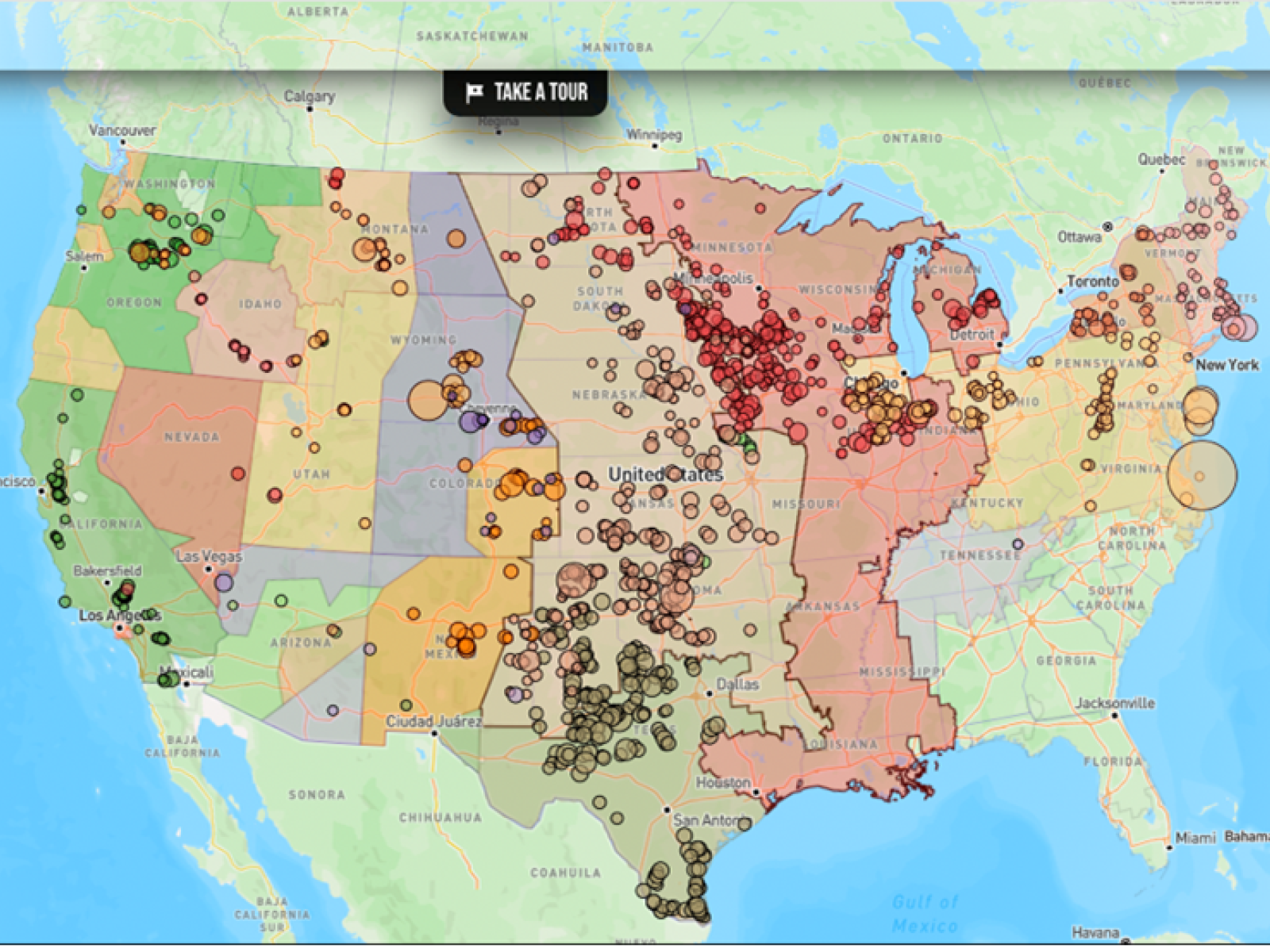Expanding Data Tools for a Resilient Grid
Updated database supports integration of energy sources

Mapping and visualization application called windSAIL from the National Wind Power Database, developed by Pacific Northwest National Laboratory with support from the National Renewable Energy Laboratory and Lawrence Berkeley National Laboratory, that compiles synthetic wind power data based on historical weather models for existing wind power plants across the nation.
(Image: Department of Energy, Office of Energy Efficiency and Renewable Energy, Wind Data Hub)
Pacific Northwest National Laboratory (PNNL) is harnessing the power of data to help ensure a more resilient and reliable power grid. A notable example is the National Wind Power Database (NWPDB)—the largest existing dataset of wind power plant time series data in the United States.
The United States is home to some of the world’s strongest wind resources. Technical advances have made wind one of the lowest-cost energy sources nationwide, and it can boost system reliability by diversifying the nation’s energy portfolio.
The NWPDB, developed by PNNL with support from the National Renewable Energy Laboratory (NREL) and Lawrence Berkeley National Laboratory (LBNL), compiles detailed hourly synthetic wind power data based on historical weather models from plants across the nation. This approach can help inform long-term planning for sufficient power (resource adequacy modeling) by providing insights into how wind resources interact with other energy sources and load—helping planners design portfolios of complementary technologies to meet energy demand.
Led by researchers at PNNL, including Jess Barcco, Allison Campbell, Nader Samaan, Chitra Sivaraman, and Larry Berg, the NWPDB is a game changer for grid planners and researchers who rely on detailed, validated data to conduct studies on expanding capacity, ensuring that generation is sufficient to meet demand, managing disruption events, and keeping the grid balanced and stable. It’s hosted on the publicly available PNNL Wind Data Hub—an online platform that makes high-quality wind power data accessible and actionable. This includes highly detailed datasets covering short time intervals (5 minutes) developed for regions such as the Pacific Northwest, aiding in targeted comparisons and planning.
“By providing access to reliable, high-resolution wind data, we’re helping planners make smarter, more informed decisions about energy integration,” said Campbell.
A large team of researchers at PNNL contributed to the development of the database and validation tools, including Ye Liu, Matt Macduff, Sherman Beus, Ekman Kaur, and Malcolm Moncheur de Rieudotte.
Making the data easier to use
Understanding the risks and challenges of wind energy development, grid integration, and long-term operations is critical to reducing energy costs and maintaining grid reliability. The NWPDB was established to help address challenges—such as incomplete data—that can affect the reliability and efficiency of wind energy on the grid. Grid planners can query the database by using the universal U.S. Energy Information Administration (EIA) plant identifier. They can validate the synthetic data by comparing it with actual data for each electricity provider region (balancing authority).
With support from the Department of Energy’s Wind Energy Technologies Office, the NWPDB was designed according to industry stakeholder feedback gathered through surveys. It includes a built-in validation tool called WE-Validate, which allows users to compare synthetic power data in the NWPDB with real data from their own facilities.
The next version, NWPDB2, offers a longer historical baseline and improved accuracy checks. These enhancements will help planners better understand how future grid scenarios might unfold by factoring in different types of disruptions and planning approaches. It will help them estimate reserve power needs and better understand where uncertainty arises in the process of converting wind into electricity.
“Expanding the database to cover additional years helps us capture a wider range of weather conditions and system behaviors,” said Samaan. “Collecting historical actual wind power plants outputs and comparing it with the database synthetic data to identify the level of error in the synthetic data, will increase grid planners’ confidence in using the database. That kind of insight supports more resilient grid planning and improves how we prepare for future energy challenges.”
The database has an associated flexible user-interactive visual tool called wind Synthesis and Analytics for Interconnection Locations (windSAIL) that enables the user to visually inspect the data shape from different resources of synthetic and actual data. This visual analytic tool offers valuable input to improve the accuracy and applicability of synthetic wind profiles included in the database.
More than a database: A hub for wind data innovation
While the NWPDB is a cornerstone resource, it’s just one part of the broader Wind Data Hub, which combines field and modeled wind data into one easy-to-access platform. The hub offers powerful features, such as automated data collection, monitoring, and visualization.
Users can explore a range of real-world and simulated data, including measurements from remote sensing tools as well as direct atmospheric and oceanographic measurements. The platform is designed to support the entire wind energy ecosystem, including academic researchers, utility planners, and developers. Ongoing industry engagement will emphasize production-grade, plant-level data acquisition, validation, and collaborative tool enhancement.
Learn more about PNNL’s Wind Data Management capability.
Published: July 14, 2025